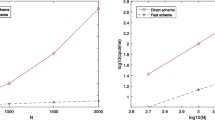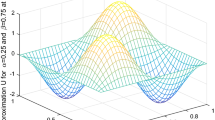Abstract
The numerical analysis of time fractional evolution equations with the second-order elliptic operator including general time–space dependent variable coefficients is challenging, especially when the classical weak initial singularities are taken into account. In this paper, we introduce a concise technique to construct efficient time-stepping schemes with variable time step sizes for two-dimensional time fractional sub-diffusion and diffusion-wave equations with general time–space dependent variable coefficients. By means of the novel technique, the nonuniform Alikhanov type schemes are constructed and analyzed for the sub-diffusion and diffusion-wave problems. For the diffusion-wave problem, our scheme is constructed by employing the recently established symmetric fractional-order reduction method. The unconditional stability of proposed schemes is rigorously discussed under mild assumptions on variable coefficients and, based on reasonable regularity assumptions and weak time mesh restrictions, the second-order convergence is obtained with respect to discrete \(H^1\)-norm. Numerical experiments are given to demonstrate the theoretical statements.
Similar content being viewed by others
References
Alikhanov, A.A.: A new difference scheme for the time fractional diffusion equation. J. Comput. Phys. 280, 424–438 (2015)
Alinhac, S.: Hyperbolic Partial Differential Equations. Springer, Dordrecht (2009)
Chen, H., Stynes, M.: Error analysis of a second-order method on fitted meshes for a time-fractional diffusion problem. J. Sci. Comput. 79, 624–647 (2019)
Cui, M.: Compact exponential scheme for the time fractional convection–diffusion reaction equation with variable coefficients. J. Comput. Phys. 280, 143–163 (2013)
Fa, K.S., Lenzi, E.K.: Time-fractional diffusion equation with time dependent diffusion coefficient. Phys. Rev. E 72, 011107 (2005)
Ji, B., Liao, H.L., Gong, Y., Zhang, L.: Adaptive second-order Crank–Nicolson time-stepping schemes for time-fractional molecular beam epitaxial growth models. SIAM J. Sci. Comput. 42, B738–B760 (2020)
Jiang, S., Zhang, J., Zhang, Q., Zhang, Z.: Fast evaluation of the Caputo fractional derivative and its applications to fractional diffusion equations. Commun. Comput. Phys. 21, 650–678 (2017)
Jin, B., Li, B., Zhou, Z.: Subdiffusion with a time-dependent coefficient: analysis and numerical solution. Math. Comput. 88, 2157–2186 (2019)
Jin, B., Li, B., Zhou, Z.: Subdiffusion with time-dependent coefficients: improved regularity and second-order time stepping. Numer. Math. 145, 883–913 (2020)
Kopteva, N.: Error analysis of the L1 method on graded and uniform meshes for a fractional-derivative problem in two and three dimensions. Math. Comput. 88, 2135–2155 (2019)
Lee, H., Lee, J., Sheen, D.: Laplace transform method for parabolic problems with time-dependent coefficients. SIAM J. Numer. Anal. 51, 112–125 (2013)
Li, B., Wang, T., Xie, X.: Numerical analysis of two Galerkin discretizations with graded temporal grids for fractional evolution equations. J. Sci. Comput. 85, Article number: 59 (2020)
Liao, H.L., Li, D., Zhang, J.: Sharp error estimate of a nonuniform L1 formula for time-fractional reaction–subdiffusion equations. SIAM J. Numer. Anal. 56, 1112–1133 (2018)
Liao, H.L., McLean, W., Zhang, J.: A discrete Grönwall inequality with applications to numerical schemes for subdiffusion problems. SIAM J. Numer. Anal. 57, 218–237 (2019)
Liao, H.L., McLean, W., Zhang, J.: A second-order scheme with nonuniform time steps for a linear reaction-subdiffusion problem. Commun. Comput. Phys. 30, 567–601 (2021)
Liao, H.L., Tang, T., Zhou, T.: A second-order and nonuniform time-stepping maximum-principle preserving scheme for time-fractional Allen–Cahn equations. J. Comput. Phys. 141, 109473 (2020)
Liao, H.L., Yan, Y., Zhang, J.: Unconditional convergence of a two-level linearized fast algorithm for semilinear subdiffusion equations. J. Sci. Comput. 80, 1–25 (2019)
Luskin, M., Rannacher, R.: On the smoothing property of the Galerkin method for parabolic equations. SIAM J. Numer. Anal. 19, 93–113 (1982)
Lyu, P., Liang, Y., Wang, Z.: A fast linearized finite difference method for the nonlinear multi-term time-fractional wave equation. Appl. Numer. Math. 151, 448–471 (2020)
Lyu, P., Vong, S.: A symmetric fractional-order reduction method for direct nonuniform approximations of semilinear diffusion-wave equations, submitted. arXiv:2101.09678 [math.NA]
Mainardi, F., Paradisi, P.: Fractional diffusive waves. J. Comput. Acoust. 9, 1417–1436 (2001)
Metzler, R., Klafter, J.: The random walk’s guide to anomalous diffusion: a fractional dynamics approach. Phys. Rep. 339, 1–77 (2000)
Mustapha, K.: FEM for time-fractional diffusion equations, novel optimal error analyses. Math. Comput. 87, 2259–2272 (2018)
Podlubny, I.: Fractional Differential Equations. Academic Press, New York (1999)
Stynes, M., O’Riordan, E., Gracia, J.L.: Error analysis of a finite difference method on graded meshes for a time-fractional diffusion equation. SIAM J. Numer. Anal. 55, 1057–1079 (2017)
Sun, Z.Z.: An unconditionally stable and \({{\cal{O}}}(\tau ^2 + h^4)\) order \(L_\infty \) convergent difference scheme for linear parabolic equations with variable coefficients. Numer. Methods Partial Differ. Equ. 17, 619–631 (2001)
Vong, S., Lyu, P., Wang, Z.: A compact difference scheme for fractional sub-diffusion equations with the spatially variable coefficient under Neumann boundary conditions. J. Sci. Comput. 66, 725–739 (2016)
Wang, Y.M.: A compact finite difference method for a class of time fractional convection–diffusion-wave equations with variable coefficients. Numer. Algorithms 70, 625–651 (2015)
Wei, Y., Lü, S., Chen, H., Zhao, Y., Wang, F.: Convergence analysis of the anisotropic FEM for 2D time fractional variable coefficient diffusion equations on graded meshes. Appl. Math. Lett. 111, 106604 (2021)
Wei, Y., Zhao, Y., Wang, F., Tang, Y., Yang, J.: Superconvergence analysis of anisotropic FEMs for time fractional variable coefficient diffusion equations. Bull. Malays. Math. Sci. Soc. 43, 4411–4429 (2020)
Yang, X., Zhang, H., Xu, D.: Orthogonal spline collocation scheme for multiterm fractional convection–diffusion equation with variable coefficients. Numer. Methods Partial Differ. Equ. 34, 555–574 (2018)
Zhang, Q., Liu, L., Zhang, C.: Compact scheme for fractional diffusion-wave equation with spatial variable coefficient and delays. Appl. Anal. (2020). https://doi.org/10.1080/00036811.2020.1789600
Zhao, X., Xu, Q.: Efficient numerical schemes for fractional sub-diffusion equation with the spatially variable coefficient. Appl. Math. Model. 38, 3848–3859 (2014)
Acknowledgements
The authors would like to thank the referees for their valuable comments and suggestions which lead to a significant improvement of this article.
Author information
Authors and Affiliations
Corresponding author
Additional information
Publisher's Note
Springer Nature remains neutral with regard to jurisdictional claims in published maps and institutional affiliations.
P. Lyu is supported by the Fundamental Research Funds for the Central Universities (JBK2102010), and the National Natural Science Foundation of China (12101510 and 12071373). S. Vong is funded by The Science and Technology Development Fund, Macau SAR (File No. 0005/2019/A) and University of Macau (File No. MYRG2018-00047-FST).
Appendix
Appendix
1.1 The Coefficients of Alikhanov Formulas
The coefficients \(A_{n-k}^{(n)}\) of the Alikhanov formula on general meshes are defined as ([15])
where
with \(\rho _k:=\tau _k/\tau _{k+1}\) being the local time step-size ratios. It has been proved in [14, 15] that the discrete coefficients of the nonuniform Alikhanov formula (with \(\pi _A=11/4\) and \(\rho =7/4\), where \(\rho :=\max _{k}\{\rho _k\}\) is the maximum step-size ratio) satisfy two basic properties:
- A1.:
-
The discrete kernels are positive and monotone: \(A_0^{(n)}\ge A_1^{(n)}\ge \cdots \ge A_{n-1}^{(n)}>0\);
- A2.:
-
The discrete kernels fulfill \(A_{n-k}^{(n)}\ge \frac{1}{\pi _A}\int _{t_{k-1}}^{t_k}\frac{\omega _{1-\beta }(t_n-s)}{\tau _k}\,\mathrm {d}s\) for \(1\le k\le n\le N\).
1.2 The Proof of (2.1)
We will go through the proof of [14, Lemma A.1] to show that
for \(1\le n\le N\) and \(A_1^{(1)}:=0\).
For fix n, denote
Then
where the identity \(2\mathbf{z}^{n}-(\mathbf{z}^{k}+\mathbf{z}^{k-1})=\mathbf{z}^{k}-\mathbf{z}^{k-1}+2\sum _{j=k+1}^n(\mathbf{z}^{j}-\mathbf{z}^{j-1})\) has been employed in the third equality.
Next, introduce the quantities
It holds that \(\mathbf{z}^{j}-\mathbf{z}^{j-1}=B_j(\mathbf{w}^j-\mathbf{w}^{j-1})\) for \(2\le j\le n\), and \(B_1\ge B_2\ge \cdots \ge B_n\) (according to the monotone property in A1). Then
because \(\mathbf{Q}^{(n)}\) is a positive definite matrix. Hence, the inequality (7.1) is valid since \(\mathbf{w}^n=({{\mathcal {D}}}_\tau ^\beta \mathbf{z})^{n-\theta }\) and \(B_n=1/A_0^{(n)}\). Similarly, it is easy to trace the remaining parts of [14, Lemma A.1] to check inequality (7.2).
According to [14, Lemma 4.1] and [15, Corollary 2.3], with the maximum time-step ratio \(\rho =7/4\), we have
which further leads to (2.1) by a simple combination of (7.1) and (7.2).
1.3 Truncation Error Analysis
The truncation errors in (3.19) and (4.16) are given by
for \(\mathbf{x}_h\in \Omega _h\) and \(1\le n\le N\).
We first study the spatial error \({{\mathcal {S}}}(\mathbf{x}_h,t_{n-\theta })\). By the Taylor expansion (see also [26, eq. (31)]), we can take a continuous function \({\xi }^n(\mathbf{x})\) such that
where \(\mathbf{x}_h\in \Omega _h\) and \(1\le n\le N\), and \(|{\xi }^n(\mathbf{x}_h)|\le C(h_x^2+h_y^2)\) provided that \(\Vert u\Vert _{H^4}\le C\) and \(p_k(\mathbf{x},\cdot )\in {{\mathcal {C}}}^3(\Omega )\) for \(k=1,2\).
Similarly, there is a continuous function \(\eta ^n(\mathbf{x})\) such that
where \(\mathbf{x}_h\in \Omega _h\) and \(1\le n\le N\), and \(|{\eta }^n(\mathbf{x}_h)|\le C(h_x^2+h_y^2)\) provided \(\Vert u\Vert _{H^3}\le C\) and \(|p_k(\mathbf{x},\cdot )|\le C\) for \(k=3,4\).
Hence, based on V2 and the regularity assumption (1.7), we have
By the Taylor expansion with integral remainder, we further get that
for \(0\le i\le M_x,~1\le j\le M_y-1\), and
for \(1\le i\le M_x-1,~0\le j\le M_y\). Similar formulations work for \(\delta _x\eta ^n(x_{i+\frac{1}{2}},y_j)\) and \(\delta _y\eta ^n(x_i,y_{j+\frac{1}{2}})\). Thus, under the assumptions in V2 and (1.7), it is easy to know that
For the temporal truncation errors, according to [20, Lemma 6.1], we have
Referring to [20, eqs. (7.5), (7.6) and (7.8)], similar to the estimation of \(\Vert \nabla _h {{\mathcal {S}}}(\mathbf{x}_h,t_{n-\theta })\Vert \), we have
for \(1\le n\le N\), provided that assumptions in V2 and (1.8)–(1.9) are valid.
Rights and permissions
About this article
Cite this article
Lyu, P., Vong, S. Second-Order and Nonuniform Time-Stepping Schemes for Time Fractional Evolution Equations with Time–Space Dependent Coefficients. J Sci Comput 89, 49 (2021). https://doi.org/10.1007/s10915-021-01661-2
Received:
Revised:
Accepted:
Published:
DOI: https://doi.org/10.1007/s10915-021-01661-2




